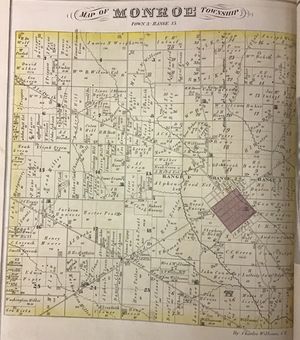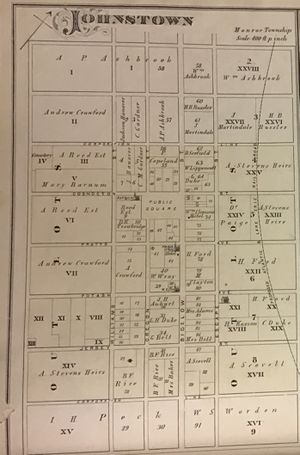Monroe Township
The township contains the municipality of Johnstown, which was elevated from the status of village to city in the 2020 census. The geography of the Monroe Township resembles its neighbors – slightly rolling hills with a few small runs. Raccoon Creek is the most notable stream. Forests gave way to pastureland and farming with European settlement [1]
Contents
Native American Presence
Unlike many parts of the county, Monroe Township has little evidence of Native American Moundbuilders. There was, however, an established presence of Wyandot inhabitants at the time of European settlement. A sizable Native American settlement once stood a mile north of present-day Johnstown along Raccoon Creek. Some accounts note the presence of a Native village on the site as early as the 1780s, when Billy Dragoo, a young boy taken captive by a Shawnee war party in 1786, passed through the village. [2] This Wyandot town, called "Racoon Town," disappeared after the purchase of the land by settlers Charles and George Green in 1807, but a Native American presence and population remained in the area until the War of 1812. [3]
European Settlement
George Evans and his family were the first European settlers to arrive in the area in 1806. They were followed by Charles and George Green in 1807 with their purchase of property around "Racoon Town." The Greens and their descendants had large families, leaving a demographic mark upon the township; in 1881, the wife of George Green, Diana, still lived in the township at the age of ninety-two and was a matriarch over a large family of seventeen children and one-hundred grandchildren. [4] Population growth spurred by the Greens and other settlers led to the formation of Monroe Township in 1812. At the time it was founded, Monroe encompassed what was to become Liberty, Bennington, and Hartford Townships. The last subdivision- Liberty Township in 1827- left Monroe in its current state.Johnstown
The village of Johnstown was founded in 1813 by Dr. Oliver Bigelow [5] Bigelow, a transplant from New York, had purchased four thousand acres in the township in 1810. He donated the property for the town's streets, square, and cemetery, where he himself would be buried at his death in 1817. The primary village industry in its first decades was tanning, leading to modest population growth of about two-hundred residents by 1830. The village changed little in the mid-nineteenth century until the arrival of rail lines in the 1880s. It experienced modest growth into the early 20th century, yet retained its village status and small-town aesthetic.[6]
The Ashbrook Family
Among the most prominent citizens of Johnstown and Monroe Township were the Ashbrook Family. William A. Ashbrook Sr. was born in Licking County in 1824 and lived as a farmer, dedicating his time to serve in local positions and offices. One of his children, William A. Ashbrook Jr. was born in Johnstown in 1867. In his late teens, William Jr. had inherited the village's fledgling newspaper, the Johnstown Independent, in 1884 after its purchase by Burton Ashbrook, his brother. After his brother's death, William ran the paper himself as a journalist and editor. His business interests extended to investments in banking in 1889 and later insurance. He became the village's postmaster in 1893 and embarked upon a political career with the Democratic Party in the 1890s. [7] In 1904, William A. Ashbrook was elected to the Ohio State House of Representatives, and then elected to the United States Congress to serve in Washington D.C. Ashbrook served in this position from 1907-1920. Suffering defeat in the 1920 election, Ashbrook would return to life in Johnstown before mounting a successful bid to retake his congressional seat in 1935, which he held until his death in 1940. [8] William's son, John M. Ashbrook, followed in his father's footsteps as the publisher of the Johnstown Independent and as a Congressman, serving as a Republican for the 17th Ohio congressional District from 1961 until his premature death in 1982. [9]
Recent Growth
Monroe Township and Johnstown, like many communities in the Western half of Licking County, experienced substantial growth after 2000 with the expansion of Columbus and Franklin County municipalities. New subdivisions and commercial growth in the 21st century led to the transition of Johnstown's municipal status of village to a city of over 5,000 inhabitants in the 2020 census. [10] The changes and growth continue for the area with the announcement in 2022 of the Intel microchip factory construction in neighboring Jersey Township.
For more information see also:
https://johnstownohio.org/history
J.G.
Return to Townships and Communities main page.
References
- ↑ Hill, N., History of Licking County, (1881), 518
- ↑ "'Indian' Billy Dragoo lived two lives on the frontier," Columbus Dispatch, Feb. 15, 2012
- ↑ Hill, N., History of Licking County, (1881), 518
- ↑ Hill, N., History of Licking County, (1881), 518
- ↑ Brister, E., Centennial History, (1909), 249
- ↑ "A Brief History of Johnstown, Ohio," Johnstown Sesquicentennial, (1963), 15
- ↑ Memorial Record of Licking County, Ohio, (1894), 196.
- ↑ "A Brief History of Johnstown, Ohio," Johnstown Sesquicentennial, (1963), 15
- ↑ "Ashbrook Death Triggers Wave of Shock, Mourning," Newark Advocate, Apr. 26, 1982, 1
- ↑ https://johnstownohio.org/history

